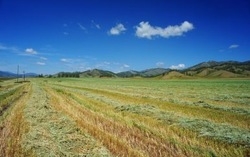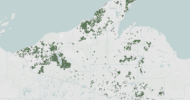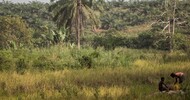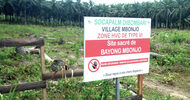
The Russian government has actively supported foreign investment in Siberian agriculture, making 1 million hectares of arable land in the Far Eastern Federal District available to foreign buyers (Photo: Pxhere)
The Dormant Breadbasket of the Asia-Pacific
The promise of Siberian agriculture could meet Asia’s growing food demand.
By Maarten Elferink and Florian Schierhorn
Countries in the Asia-Pacific region are importing an increasing amount of grain and oilseed to match their growing domestic demand. East Asian countries imported 72.5 million tonnes of grain from around the world last season, an increase of 52 percent over the last 10 years. Japan and South Korea stand out in corn imports, respectively the second and third largest buyer worldwide, and China has surpassed Saudi Arabia as the largest buyer of barley. Southeast Asian grain imports, although a third smaller than the amount destined for East Asia, grew even faster, by 129 percent over the same period, and are forecast to maintain strong growth in the next years – especially as wheat consumption in Southeast Asia is far below the global per capita average of 78 kilograms per year, and even around three times lower than in China and India. Indonesia, for example, is already the second largest buyer of wheat in the world, but has an annual per capita consumption of only 29 kilograms.
Combined, the import volume of East Asia and Southeast Asia account for nearly one third of all grain in global markets last season. The growth in population coupled with rising incomes, spurring consumption of protein-rich diets (more meat and poultry) and a preference for wheat products such as bread or noodles (over traditional rice-based products), are boosting demand. In China, feed for the proliferating domestic pig and poultry sectors is the main driver of surging grain imports. China’s unparalleled demand becomes especially clear through another key feed ingredient – the oilseed soybean. Local buyers imported a staggering 94.1 million tonnes last season, equivalent to 61 percent of all soybeans exported. As recent as 1995 China was still self-sufficient in soybean production and, although domestic production has hardly changed in volume since then, it now fulfills only about 14 percent of demand. With domestic meat consumption expected to continue growing, so will Chinese imports of feed ingredients and soybean in particular.
Yet it is not just food demand in Asia that is growing at unprecedented rates; worldwide food demand is expected to increase anywhere between 59 percent and 98 percent by 2050. This will drastically transform agricultural markets. Across the globe, farmers need to grow more, by increasing their crop land or enhancing productivity on existing lands. Nonetheless, there are significant hurdles ahead in realizing this. Average global crop yields — the amount of crops harvested per unit of land cultivated — are increasing too slowly to meet the forecast demand, while urbanization and underinvestment in agriculture are exacerbating this situation. Another major obstacle is climate change, which already affects agriculture worldwide, as increasing water-scarcity, rising temperatures and extreme weather events have diminished harvests in numerous countries recently.
It is important to understand the systemic risk of these climate-related supply volatilities in major crop producing countries. China, for example, is by far the largest consumer of wheat in the world and only second to the United States in consumption of corn, yet it is almost self-sufficient in production of these crops. When domestic reserves dwindle due to possible climate-induced harvest failures in the near future, it could quickly force Chinese buyers to import substantially more grain to meet demand, taking a significant chunk out of global supplies – in turn negatively impacting prices and food security worldwide. These effects will be compounded when major grain exporting countries are facing disappointing harvests simultaneously, as evidenced by the global food crises of 2008 and 2011. Still, some colder regions in the northern latitudes are expected to (initially) benefit from climate change. Countries such as Canada and Russia, where longer and warmer growing seasons are already bolstering crop production. One of the most promising regions is the vast Asian part of Russia, named Siberia.
With 13.1 million square kilometers, Siberia is larger than Brazil and the European Union combined. From the Urals to the Pacific Ocean, Siberia stretches across 6,000 kilometers and contains 28 percent of the land currently cultivated in Russia. Nevertheless, it is one of the least populated regions on earth with less than 3 people per square kilometer and a great share of the crops harvested there are ultimately destined for consumers in other regions. Siberia’s agriculture is today mainly confined to two areas. One is in the Russian Far East, where the warm and moist summers support Russia’s largest soybean growing area, which has profited substantially from the boom in Chinese soybean demand across the Amur river. Another and agriculturally much more important region is the Western Siberian grain belt. Fertile Chernozem soils, as found in Ukraine and the south of Russia, and seemingly endless crop fields characterize this region. Last season 22 million tonnes of grain were harvested here, as well as nearly a third of all Russian rapeseed. The area is dominated by large-scale agriculture with corporate farms typically managing between 3,000 to 10,000 hectares of farmland.
Agriculture has been practiced in Siberia by indigenous tribes for millennia on subsistence level, but it was only when Russian settlers arrived in the 16th century that larger areas became cultivated, encouraged by tax breaks and free land allocation. By the late 19th century these settlers created one of the most productive farming regions in the Russian Empire. Inextricably linked to the development of the rail network that connected Siberia to the industrial heartlands of European Russia and its sea ports, grain harvests went from 1.4 million tonnes in the mid-19th century to over 7 million tonnes at the beginning of the 20th century.
As Russian grain exports in that epoch reached far and wide, many became familiar with the exceptional quality of Siberian grain. Between 1898 and 1900 the U.S. Department of Agriculture even sent a botanist, Mark A. Carleton, on several expeditions to the region to find suitable wheat cultivars for the Great Plains of the United States. With the various new wheat variants he introduced from Siberia and neighboring regions, Carleton transformed American farming. Unsurprisingly, Siberian hard red and durum wheat, like its offspring grown by American and Canadian farmers today, was already famous for its milling quality back then and a great share of it was exported to Europe.
By 1917, the year of the Russian Revolution, Siberian grain harvest amounted to 18 million tonnes, or 17 percent of the Russian total. The rise of the Soviet Union put an end to the lucrative Siberian export, as production was directed to satisfy domestic demand. Regional crop farming continued to grow though and the so-called “virgin land campaign” in the 1950s and early 1960s greatly expanded the agricultural land base. As low and volatile yields in European Russia increasingly threatened domestic food security, Nikita Khrushchev ordered a vast cropland expansion in the natural steppes of Siberia and northern Kazakhstan. During the campaign, which lasted nine years, 45 million hectares were newly plowed here – an unparalleled cropland expansion endeavor worldwide.
Following the collapse of the Soviet Union, Russian agriculture received a major blow. As the free-market economy took hold and agricultural subsidies evaporated, large areas of cropland were abandoned. From 1990 to 2007, Siberian croplands declined by 39 percent or 13.7 million hectares. To put that number in perspective, Germany, the second largest grain producer in the EU, currently cultivates a little more than 12 million hectares of land. Since 2007, approximately 1.1 million hectares of the abandoned cropland in Siberia has been replanted. Still, Siberia harbors one of the largest reserves of idle cropland in the world.
Furthermore, it is one of the most underperforming breadbaskets worldwide. The popular practice of summer fallow after several years of planting spring cereals, entailing that fields do not generate any crops every third or fourth year, is a major factor in Siberia’s underperformance. The region also has an estimated yield gap — the difference between existing and potential yield — of more than 50 percent, meaning that Siberian yields could be increased from the current 1.8 tonnes per hectare to 3.6 tonnes or more. Low or no usage of mineral fertilizer, low-quality seeds and insufficient agricultural equipment are the main reasons why Siberian yields are so low. For example, a recent survey found that only 32 percent of the corporate and private farms applied mineral fertilizer to their fields, making Siberia one of the greatest sources for organic grains but noticeably dampening harvest volumes in comparison to other Russian regions. Plus, adequate insurance schemes are almost entirely absent today in Russian agriculture, making weather-related risks difficult to manage.
Although some Siberian farmers in the south are anticipated to face production declines due to climate change, the perspectives will improve significantly for the rest of Siberia. With the growing seasons becoming longer and warmer, crop yields are anticipated to improve substantially. Moreover, abandoned cropland and forest areas further north are becoming more attractive for cultivation, with April-July temperatures now on average 1.3 to 2 degrees Celsius higher than in 1960. Nonetheless, (re)cultivation of these lands could release significant amounts of carbon stored in the soil and plants and aggravate climate change. Sustainable intensification of current agricultural lands should therefore have priority over cropland expansion. Substitution of summer fallows, efficient no-till crop rotation schemes, increased water-use-efficiency, and equipment sharing programs are the most cost-effective approaches to a sustainable intensification strategy in Siberia.
The logical destination for Siberian crop surplus is East and Southeast Asia, due to their proximity and large demand. However, in 2017 only 3.3 percent of all Russian grain exports went to East Asia and 7.8 percent to Southeast Asia. The Russian government is acutely aware of the potential for increased Siberian agricultural exports and has actively pursued foreign policy, regulation and the development of infrastructure to that end. In 2015 it created a free-port zone in Primorsky Krai, the administrative region that borders the Pacific in the east and the Chinese border in the west. Named the Free Port of Vladivostok, its benefits include a free-customs regime for resident companies, lower corporate taxes, fast-track VAT reimbursement, and a simplified visa process for foreigners.
Vladivostok is directly linked to the Trans-Siberian Railway network, connecting the Western Siberian grain belt with the free port over more than 5,000 kilometers. This railway, however, has limited capacity and although there are plans to increase its capacity, the infrastructure network has yet to expand to accommodate this growth. The Free Port zone, which handles mainly energy, metals and mining commodities alongside containers, is also not equipped to efficiently load bulk grain and oilseed. To remedy this, a relatively minor fishing port called Zarubino, at the southern tip of the Free Port zone, was designated to become home to the first grain terminal on the Pacific coast of Russia. The project is largely supported by Chinese investors, who are interested in creating port access for the neighboring Chinese provinces Jilin and Heilongjiang, the country’s largest corn and soybean production areas. Currently, crops from these provinces need to be transported up to 1,000 km by a congested railway to the nearest Chinese port in the Bohai Bay, while Zarubino is a mere 50 km from the border with China. The terminal was to be completed by 2020 and initially slated to have an annual capacity of 40 million tonnes. Due to various setbacks, the project has yet to get off the ground.
Besides infrastructural issues, sparsely populated Siberia also suffers from a lack of skilled labor. To counter this the Russian government has actively supported foreign investment in the region. Last year for example, it has made 1 million hectares of arable land in the Far Eastern Federal District available to foreign buyers, who are normally only eligible for leasehold. Although most of the land is located in remote regions with low productivity, many Chinese buyers indicated interest. Wealthy farmers from China have been moving into the eastern part of Siberia ever since the collapse of the USSR, as centrally planned local economies imploded and agricultural subsidies disappeared. As crop production in some regions of China becomes more difficult in the face of climate change, more Chinese farmers may look north of the border for better opportunities.
Agricultural (land) investments are also attractive to institutional investors, in particular long-term investors like pension funds or sovereign wealth funds, as these investments have historically delivered stable returns, increased diversification, and outpaced inflation. Various institutional investors have committed to Russian agriculture recently, mostly through shareholdings in foreign listed groups focused on farmland acquisition and agribusiness. Among the major funds that invested in Russian farming are Sweden’s AP2 pension fund ($38 billion assets under management or AUM), Dutch pension fund PFZW ($234 billion AUM), California’s CalPERS pension fund ($365.5 billion AUM), Nordea Investment Funds, and insurer Swiss Life. Some investors have even acquired Russian farmland directly, such as New York based hedge fund Och-Ziff Capital and Harvard University’s endowment fund. The most active foreign investors are the large commodity traders and food processors, who invest not only in land and farming, but also in infrastructure (storage and export terminals) and processing (grain milling or oilseed crushing).
Investment risks remain substantial however, as reflected in the overall level of foreign investment in Russia. The risks are not specific to agriculture, but inherent to investing in Russia. Unstable regulation, red tape, corruption, and geopolitical uncertainty are some of the key concerns. More supportive economic policies and a better regulatory framework, as well as public spending on infrastructure would go a long way in improving investment climate in Russia, regardless of economic sanctions.
As surpluses in other growing regions are anticipated to decline, countries will compete for food supplies and put pressure on global prices, which will negatively affect food security worldwide. The underperforming agricultural sector of Siberia has great potential to support the growing demand of Russia’s neighbors in the Asia-Pacific. Local crop production can be increased significantly, especially through sustainable intensification. The existing infrastructure, albeit aging and insufficient for cost-competitive handling of agricultural bulk, has the potential to facilitate large agricultural exports eastward. Like Catherina the Great and her grandson Alexander I, who both successfully promoted the immigration of vast numbers of German farmers to areas that were sparsely populated and transformed them to what remain today the most productive agricultural regions of Russia and Ukraine, the current Russian government should consider policies that will make it more attractive for (foreign) investors to settle in Siberia if it earnestly wants to unlock the agricultural potential of the region. Siberia could become the breadbasket of the Asia-Pacific and boost global food security in the process.
Maarten Elferink is the founder and Managing Director of Vosbor, an Amsterdam based trading group, specializing in the origination of soft commodities and derivative products across Russia and Kazakhstan for merchandising in the Asia-Pacific region.
Dr. Florian Schierhorn is a post-doctoral researcher at the Leibniz Institute of Agricultural Development in Transition Economies in Halle, Germany and was selected for participation in the Lindau Nobel Laureate Meeting on Economic Sciences in 2014. Dr. Schierhorn is mainly working on trade-environment interactions as well as on impacts of climate change on crop yields.













